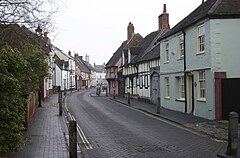
Wickham is a village in the civil parish of Wickham and Knowle, in the Winchester district, in the county of Hampshire, England. It is about 3 miles north of Fareham. In 2021 it had a population of 2173. At the 2001 census, it the parish a population of 4,816, falling to 4,299 at the 2011 Census.

Romsey is a town in the Test Valley district of Hampshire, England. The town is situated 7 miles (11 km) northwest of Southampton, 11 miles (18 km) southwest of Winchester and 17 miles (27 km) southeast of Salisbury. It sits on the outskirts of the New Forest, just over 3 miles (4.8 km) northeast of its eastern edge. The population of Romsey was 14,768 at the 2011 census.
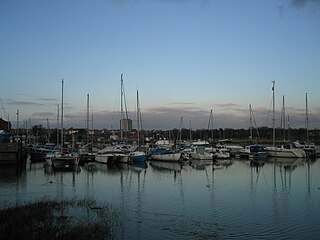
Fareham is a market town at the north-west tip of Portsmouth Harbour, between the cities of Portsmouth and Southampton in south east Hampshire, England. It gives its name to the Borough of Fareham. It was historically an important manufacturer of bricks, used to build the Royal Albert Hall, and grower of strawberries and other seasonal fruits. In 2011 it had a population of 42,210.
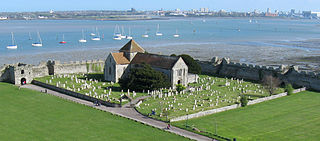
Portchester is a village in the borough of Fareham in Hampshire, England. It is 4 miles (6.4 km) northwest of Portsmouth and around 18 miles east of Southampton on the A27 road. Its population according to the 2011 United Kingdom census was 17,789.

The Borough of Fareham is a local government district with borough status in Hampshire, England. Its council is based in Fareham. Other places within the borough include Portchester, Hill Head, Sarisbury, Stubbington, Titchfield and Warsash. The borough covers much of the semi-urban area between the cities of Southampton and Portsmouth, and is part of the South Hampshire conurbation. The neighbouring districts are Eastleigh, Winchester, Portsmouth and Gosport. The district's southern boundary is the coast of the Solent.
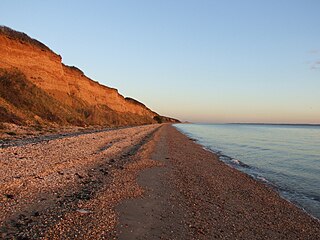
Hill Head is a residential area and village on the coast of the Solent. It is located south of Stubbington, west of Lee-on-the-Solent and south east of Titchfield, in the borough of Fareham, Hampshire.
Stubbington is a village which is located between Southampton and Portsmouth, in the county of Hampshire on the south coast of England. It is within the borough of Fareham.

The River Meon is a chalk stream in Hampshire in the south of England. It rises at East Meon then flows 34 km (21 mi) in a generally southerly direction to empty into the Solent at Hill Head near Stubbington. Above Wickham, the river runs through the South Downs National Park.
Catisfield is an area of Fareham, Hampshire, England. Originally a small village in its own right, it has now merged with the western edge of the town.

Funtley – from the Anglo-Saxon, "Funtaleg", "spring field (clearing)", is a hamlet or exurb north of Fareham, Hampshire, England. It forms a projection towards the South Downs National Park and is generally included within Fareham's population as it is within its built-up area. At present the village is unparished, as the creation of a parish council was rejected by Fareham Borough Council, despite having the support of the majority of residents.

Titchfield Abbey is a medieval abbey and later country house, located in the village of Titchfield near Fareham in Hampshire, England. The abbey was founded in 1222 for Premonstratensian canons, an austere order of priests. The abbey was a minor house of its order, and became neither wealthy nor influential during its three centuries of monastic life; the inhabitants were devoted to scholarship, as shown by their very impressive library.

West Meon is a village and civil parish in Hampshire, England, with a population of 749 people at the 2011 census.

The Titchfield Canal is a two-mile watercourse between the village of Titchfield, Hampshire, and the coast at Titchfield Haven adjacent to the modern nature reserve. Lying above and roughly parallel to the nearby River Meon it is plainly artificial, but its origins and purpose have been warmly debated.

Sarisbury is a village to the west of Park Gate within the borough of Fareham, Hampshire, in the south of England. Its focal point is Sarisbury Green and the parish church of St Paul, formerly part of Titchfield parish. In previous times it was a rural locality dependent on fruit growing. At the 2011 Census the population of the ward was 7,385. Nearby villages include Bursledon, Hamble-le-Rice and Swanwick. The name is pronounced 'Sarsbury' with the 'i' being silent.

Upham is a small village and civil parish in the south of England located in Hampshire approximately 7 miles south-east of Winchester.
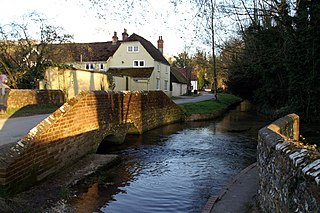
Warnford is a village and civil parish in the City of Winchester district of Hampshire, England. The parish covers 1283 hectares. The village lies on the A32 in the upper valley of the River Meon between West Meon and Exton. The population in 2019 was estimated at 220. The village is rural in character, with most of the buildings along River Lane, Lippen Lane and Hayden Lane.

North Stoneham is a settlement between Eastleigh and Southampton in south Hampshire, England. Formerly an ancient estate, manor, and civil parish, it is currently part of the Borough of Eastleigh. Until the nineteenth century, it was a rural community comprising a number of scattered hamlets, including Middle Stoneham, North End, and Bassett Green, and characterised by large areas of woodland.
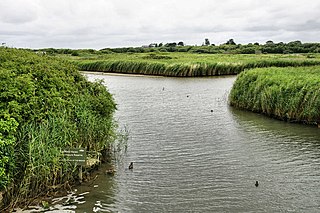
Titchfield Haven is a 134.5-hectare (332-acre) biological Site of Special Scientific Interest north-west of Gosport in Hampshire. Most of it is a local nature reserve and a national nature reserve. It is part of Solent and Southampton Water Ramsar site and Special Protection Area.
